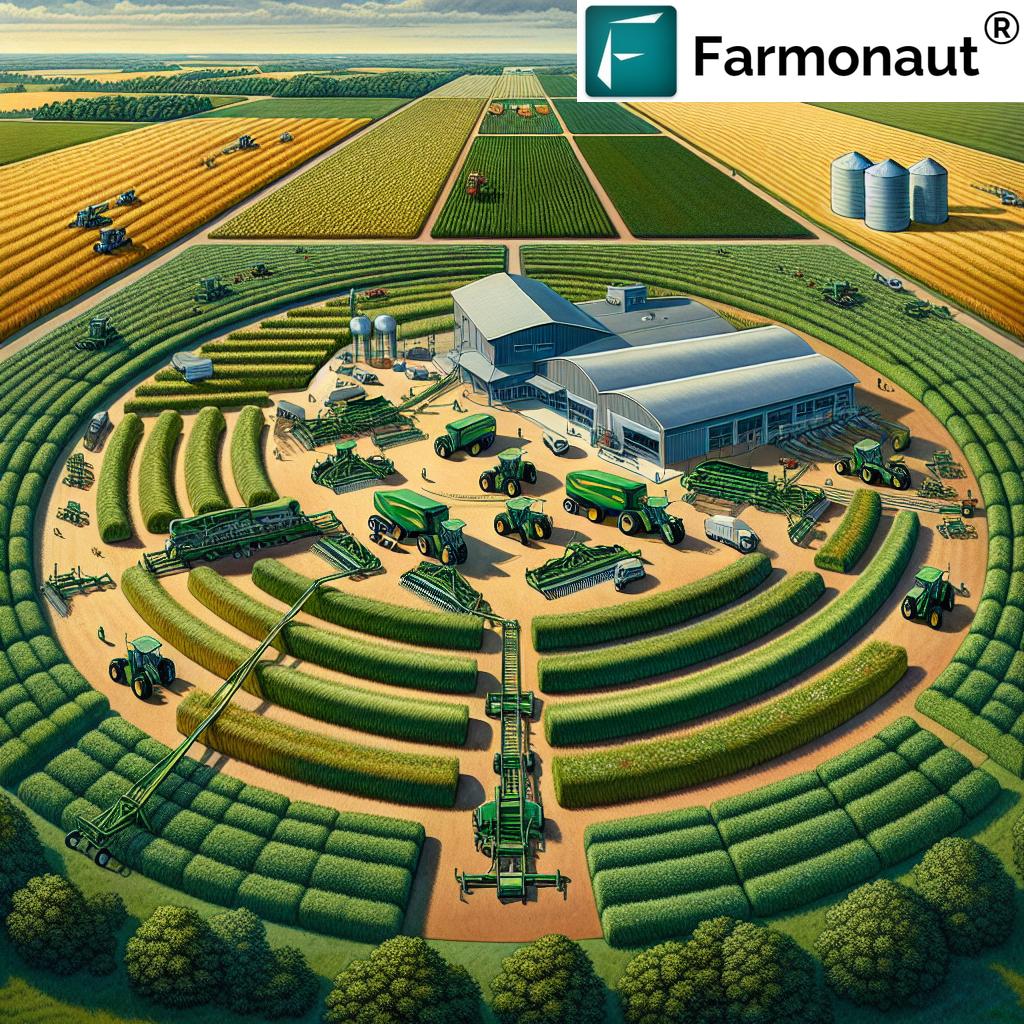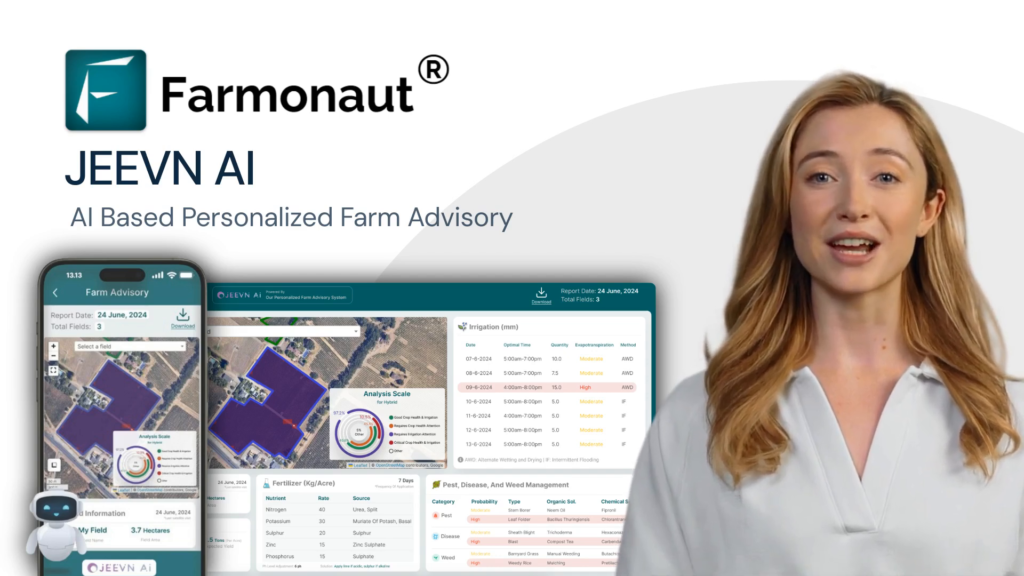Maximize Your Hay Yields: Expert Guide to Alfalfa Farming and Forage Management in Tennessee
“Alfalfa, a key forage crop, can yield up to 8 tons of hay per acre annually in optimal conditions.”
Welcome to our comprehensive guide on maximizing hay yields through expert alfalfa farming and forage management techniques in Tennessee. As your trusted partners in precision agriculture, we at Farmonaut are excited to share our knowledge and insights to help you boost your farm’s productivity and efficiency. In this blog post, we’ll delve into essential hay production techniques, forage crop management strategies, and innovative equipment that can transform your farming practices.

Whether you’re a seasoned farmer or new to the field, this guide offers valuable information on improving forage quality, reducing costs, and enhancing overall farm efficiency. Let’s dive into the world of modern hay and forage production and unlock the secrets to higher yields, better quality, and sustainable farming practices in the beautiful state of Tennessee.
Understanding Alfalfa: The King of Forages
Alfalfa, often referred to as the “Queen of Forages,” is a crucial crop for hay production and animal feeding in Tennessee and across the southeastern United States. Its high nutritional value, excellent yield potential, and ability to fix nitrogen in the soil make it an ideal choice for many farmers. Let’s explore the key aspects of successful alfalfa farming:
- Soil Requirements: Alfalfa thrives in well-drained soils with a pH between 6.5 and 7.0.
- Climate Adaptation: It’s well-suited to Tennessee’s climate, with its deep root system providing drought tolerance.
- Nutritional Value: High in protein, vitamins, and minerals, making it excellent for livestock feed.
- Yield Potential: Under optimal conditions, alfalfa can produce 4-8 tons of hay per acre annually in Tennessee.
Soil Fertility Management for Optimal Hay Production
Proper soil fertility management is crucial for maximizing alfalfa yields and ensuring high-quality hay production. Here are some key strategies:
- Soil Testing: Conduct regular soil tests to determine nutrient levels and pH.
- pH Adjustment: Apply lime as needed to maintain optimal pH levels for alfalfa growth.
- Nutrient Management: Focus on providing adequate phosphorus, potassium, and micronutrients.
- Organic Matter: Incorporate cover crops and crop residues to improve soil structure and fertility.
At Farmonaut, we understand the importance of precise soil management. Our satellite-based crop health monitoring system can help you identify areas of your field that may require additional attention, allowing for targeted nutrient application and improved overall soil fertility.
Alfalfa Seeding and Establishment Techniques
Successful alfalfa establishment is critical for long-term productivity. Consider these tips when seeding your alfalfa fields:
- Seed Selection: Choose varieties adapted to Tennessee’s climate and resistant to common pests and diseases.
- Seeding Rate: Aim for 15-20 pounds of pure live seed per acre for optimal stand density.
- Planting Depth: Plant seeds 1/4 to 1/2 inch deep in a firm, well-prepared seedbed.
- Timing: In Tennessee, spring (March-April) or late summer (August-September) are ideal planting times.
- Weed Control: Implement pre-planting weed control measures to reduce competition during establishment.
Our Jeevn AI Advisory System can provide personalized recommendations for seed selection and planting timing based on your specific field conditions and local weather patterns.
Efficient Hay Mowing Practices
Proper mowing techniques are essential for maintaining high-quality hay and promoting rapid regrowth. Consider these best practices:
- Cutting Height: Maintain a 2-3 inch stubble height to protect crown buds and encourage regrowth.
- Timing: Cut alfalfa at early bloom stage for optimal balance between yield and quality.
- Equipment: Use well-maintained, sharp mower blades to ensure clean cuts and reduce plant damage.
- Swath Management: Utilize wide swaths to speed up drying and preserve forage quality.
Our satellite-based monitoring can help you track crop growth stages and determine the optimal time for mowing, ensuring you consistently produce high-quality hay.
Innovative Hay Harvesting Equipment
Investing in modern hay harvesting equipment can significantly improve your farm’s efficiency and hay quality. Here are some innovative tools to consider:
- Triple Mowers: Increase mowing efficiency by covering more ground in less time.
- Rotary Rakes: Improve hay quality by gently raking and reducing leaf loss.
- Advanced Balers: Produce consistent, high-density bales for improved storage and transport.
- Bale Wrappers: Protect hay from weather damage and preserve nutritional value.
While Farmonaut doesn’t manufacture or sell farm machinery, our fleet and resource management tools can help you optimize the use of your hay harvesting equipment, reducing operational costs and improving overall efficiency.
Explore our API for custom integration with your farm management systems
Alfalfa Rotation Strategies for Sustainable Farming
Implementing effective rotation strategies is crucial for maintaining soil health and maximizing long-term productivity. Consider these approaches:
- Crop Diversity: Rotate alfalfa with crops like corn, soybeans, or small grains.
- Duration: Maintain alfalfa stands for 3-5 years before rotating to other crops.
- Cover Crops: Use cover crops between rotations to improve soil structure and fertility.
- Pest Management: Rotate with non-host crops to break pest and disease cycles.
Our satellite-based crop monitoring can help you track the performance of your rotations and identify areas where adjustments may be needed to optimize your farming system.

Hay Bale Storage Methods for Optimal Quality
“Proper hay bale storage can reduce dry matter losses by up to 15%, significantly improving farm efficiency.”
Proper storage is essential for maintaining hay quality and minimizing losses. Consider these storage techniques:
- Indoor Storage: Ideal for long-term preservation of hay quality.
- Outdoor Stacking: Use proper stacking techniques to shed water and minimize ground contact.
- Tarps and Covers: Protect outdoor-stored hay from weather damage.
- Elevated Storage: Use pallets or gravel pads to reduce moisture absorption from the ground.
Our Jeevn AI Advisory System can provide personalized recommendations for hay storage based on your local climate conditions and storage facilities.
Improving Forage Quality for Optimal Animal Feeding
High-quality forage is essential for efficient animal feeding and production. Here are some strategies to improve forage quality:
- Timely Harvesting: Cut alfalfa at the optimal growth stage to balance yield and nutritional value.
- Proper Drying: Ensure hay is adequately dried before baling to prevent mold growth.
- Leaf Retention: Use gentle handling techniques to minimize leaf loss during harvest and baling.
- Weed Control: Implement effective weed management to maintain pure alfalfa stands.
- Fertilization: Apply balanced fertilizers to ensure optimal plant nutrition and forage quality.
Our satellite-based crop health monitoring can help you identify areas of your field that may need attention, allowing for targeted management to improve overall forage quality.
Check out our API Developer Docs for advanced integration options
Maximizing Alfalfa Yields: Key Strategies
To achieve peak alfalfa yields in Tennessee, consider implementing these proven strategies:
- Variety Selection: Choose high-yielding, disease-resistant varieties adapted to Tennessee’s climate.
- Soil Fertility: Maintain optimal soil pH and nutrient levels through regular testing and amendments.
- Irrigation Management: Implement efficient irrigation practices to supplement rainfall during dry periods.
- Pest and Disease Control: Monitor fields regularly and implement integrated pest management strategies.
- Harvest Timing: Cut alfalfa at the appropriate growth stage to balance yield and quality.
- Stand Management: Maintain proper plant density and control weeds to maximize productivity.
Our Farmonaut platform can assist you in monitoring crop health, tracking growth stages, and identifying potential issues before they impact your yields.
Innovative Technologies in Hay and Forage Production
Embracing modern technologies can significantly enhance your hay and forage production efficiency. Here are some innovative tools to consider:
- Precision Agriculture: Use GPS-guided equipment for accurate planting, spraying, and harvesting.
- Drone Technology: Employ drones for field scouting and identifying problem areas.
- Moisture Sensors: Utilize hay moisture sensors to ensure optimal baling conditions.
- Automated Irrigation Systems: Implement smart irrigation systems to optimize water use.
- Farm Management Software: Use digital platforms to track field operations, yields, and costs.
At Farmonaut, we’re committed to making precision agriculture accessible to farmers of all scales. Our satellite-based monitoring and AI-driven advisory systems can help you leverage these technologies without the need for expensive on-farm hardware.
Sustainable Practices in Hay and Forage Farming
Implementing sustainable farming practices is crucial for long-term success and environmental stewardship. Consider these approaches:
- Conservation Tillage: Minimize soil disturbance to improve soil health and reduce erosion.
- Cover Cropping: Use cover crops to protect soil, improve fertility, and suppress weeds.
- Integrated Pest Management: Employ biological controls and targeted pesticide use to minimize environmental impact.
- Water Conservation: Implement efficient irrigation systems and water management practices.
- Biodiversity: Maintain field borders and buffer strips to support beneficial insects and wildlife.
Our Farmonaut platform can help you track and manage these sustainable practices, providing insights into their impact on your farm’s productivity and environmental footprint.
Cost Management in Hay and Forage Production
Effective cost management is essential for maintaining profitability in hay and forage production. Consider these strategies to optimize your farm’s financial performance:
- Input Optimization: Use soil tests and crop monitoring to apply inputs precisely where needed.
- Equipment Efficiency: Maintain and upgrade equipment to minimize downtime and fuel consumption.
- Labor Management: Implement efficient work practices and consider automation where appropriate.
- Marketing Strategies: Develop diverse marketing channels to maximize returns on your hay and forage crops.
- Record Keeping: Maintain detailed records to track costs and identify areas for improvement.
Our Farmonaut platform offers tools to help you track and analyze your farm’s performance, allowing for data-driven decision-making to optimize costs and improve profitability.
Alfalfa Farming Best Practices in Tennessee
| Practice | Description | Estimated Yield Impact |
|---|---|---|
| Proper pH Maintenance | Maintain soil pH between 6.5-7.0 through regular lime application | +10-15% |
| Optimal Seeding Rate | Plant 15-20 lbs of pure live seed per acre | +5-10% |
| Timely Cutting | Harvest at early bloom stage for best quality-yield balance | +15-20% |
| Irrigation Management | Provide 1-1.5 inches of water per week during dry periods | +20-30% |
| Pest Control | Implement integrated pest management strategies | +10-15% |
Leveraging Farmonaut for Hay and Forage Management
At Farmonaut, we’re committed to helping farmers optimize their hay and forage production through advanced technology. Our platform offers several key benefits:
- Satellite-Based Crop Monitoring: Track crop health and growth stages across your fields in real-time.
- AI-Driven Advisory: Receive personalized recommendations for crop management based on field conditions and weather patterns.
- Weather Forecasting: Access accurate, field-specific weather forecasts to plan your farming activities.
- Field Mapping: Create detailed field maps to support precision agriculture practices.
- Data Analytics: Analyze historical field data to inform future management decisions.
By integrating Farmonaut’s technology into your farming practices, you can make more informed decisions, optimize resource use, and ultimately improve your hay and forage yields.
Conclusion: Embracing the Future of Hay and Forage Production
As we’ve explored in this comprehensive guide, successful hay and forage production in Tennessee requires a combination of traditional farming knowledge and modern technological innovations. By implementing best practices in alfalfa farming, soil management, and harvesting techniques, while leveraging advanced tools like Farmonaut’s satellite-based monitoring and AI advisory systems, Tennessee farmers can significantly improve their yields, reduce costs, and ensure long-term sustainability.
Remember, the key to success lies in continuous learning, adapting to changing conditions, and embracing new technologies that can give you a competitive edge. Whether you’re managing a small family farm or a large agricultural operation, the strategies and tools discussed in this guide can help you maximize your hay yields and improve your overall farm efficiency.
At Farmonaut, we’re excited to be part of your journey towards more productive and sustainable farming. Our platform is designed to provide you with the insights and tools you need to make informed decisions and optimize your farming practices. We invite you to explore our services and see how we can help you take your hay and forage production to the next level.
FAQs
- What is the best time to plant alfalfa in Tennessee?
The best times to plant alfalfa in Tennessee are typically in early spring (March-April) or late summer (August-September). - How often should I cut my alfalfa for optimal yield and quality?
For optimal yield and quality, cut alfalfa when it reaches early bloom stage, which usually occurs every 28-35 days during the growing season. - What are the main pests and diseases affecting alfalfa in Tennessee?
Common pests include alfalfa weevil and potato leafhopper. Diseases to watch for include Phytophthora root rot and anthracnose. - How can Farmonaut help me improve my hay and forage production?
Farmonaut provides satellite-based crop monitoring, AI-driven advisory services, and weather forecasting to help you make informed decisions about crop management, optimizing your yields and resource use. - What are the benefits of using precision agriculture in hay production?
Precision agriculture can help optimize input use, improve yield consistency, reduce environmental impact, and increase overall farm profitability.
















